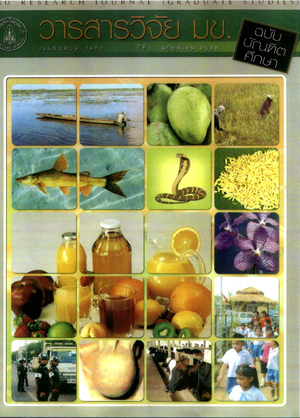Effect of Different Tropical Feed Resources on Rumen Ecology and Feed Intake of Beef Cattle ผลของแหล่งอาหารหยาบในเขตร้อนที่แตกต่างกัน ต่อนิเวศวิทยารูเมน และปริมาณการกินไดในโคเนื้อ
Keywords:
cassava hay, cassava foliage, urea-treated rice straw, rumen ecologyAbstract
การศึกษาในครังนีมีวัตถุประสงค์เพือศึกษาผลของการใช้แหล่งอาหารหยาบที่แตกต่างกันต่อนิเวศวิทยา
และปริมาณการกินได้ของโคเนิอ โดยใช้โคเนอจำนวน 4 ตัวที่ทำการเจาะกระเพาะแบบถาวร ตามแผนการ ทดลองแบบ 4x4 ลาตินสัสแควร์ มีกลุ่มทดลองตังนี้ กลุ่มทดลองที่ 1 โคเนื้อได้รับฟางหมักยูเรีย 5 เปอรัเซ็นค์ กลุ่มทดลองที่ 2 โคเนื้อได้รับมันเฮยั กลุ่มทดลองที่ 3 โคเนื้อได้รับมันสำปะหลังสด กลุ่มที่ 4 โคเนื้อได้รับ ฟางหมักยูเรียร่วมกับมันสำปะหลังสด ในอัตราส่วน 1:1 (นำหนักแห้ง) ในช่วง 14 วันแรกสัตว์ทดลองทุกตัว ได้รับอาหารข้นเสริมในอัตรา 0.3 เปอร์เซ็นต์นำหนักตัว และได้รับอาหารตามกลุ่มทดลองแบบเต็มที่ ทำการลุ่ม เก็บตัวอย่างของเหลวรูเมน และเลือดในวันสุดท้ายของแต่ละระยะทดลอง ทำการวิเคราะห์จุลนทรีย็ในรูเมนได้แก่ กลุ่มแบคทีเรียทังหมด และแบคทีเรียที่ย่อยสลายเยื่อใย แอมโมเนีย-ไนโตรเจน กรดไขมันที่ระเหยได้ และ ยูเรีย-ไนโตรเจนในกระแสเลือด ทำการลุ่มวัดค่าความเป็นกรด-ด่าง และอุณหภูมิภายรูเมนทันทีหลังจาก สุ่มเก็บตัวอย่าง จากการทดลองพบว่า การใช้ฟางหมักยูเรียเป็นแหล่งอาหารหยาบหลักทำให้ค่าความเป็น กรด-ค่าง อุณหภูมิ แอมโมเนีย-ไนโตรเจน และกรดไขมนระเหยได้ในรูเมนอยู่ในระดับที่เหมาะสม นอกจากนี้ยังพบว่า ประชากรแบคทีเรียทั้งหมด และแบคทีเรียที่ย่อยสลายเยื่อใยมากกว่ากลุ่มทดลองอื่น ๆ อย่างมีนัยสำคัญ (P < 0.05) และส่งผลต่อปริมาณการกินได้ของอาหารหยาบ และปริมาณการกินได้ทั้งหมด เพิมขึ้นอย่างมีนัยสำคัญด้วย (P < 0.05) ส่วนโคเนื้อที่ได้รับมันสำปะหลังสดเป็นแหล่งอาหารหยาบนั้น พบว่า ความเช้มข้นของกรดโพรพิออนิคเพิมขึน ในขณะที่ประชากรแบคทีเรียที่ย่อยสลายเยื่อใยลดลง และ จากการสังเกต พบว่าโคเนีอที่ได้รับมันสำปะหลังสดแบบเต็มที่นั้นจะอาการทางระบบประสาทผิดปกติ เช่น ป้สสาวะตลอดเวลา ตังนั้นการให้มันสำปะหลังสดเป็นอาหารสัตว์ควรจะมีการตากแดดก่อน และการใข้ร่วมกับ ฟางหมักยูเรียจึงน่าจะเป็นอีกหนึ่งแนวทางที่เป็นไปได้
This experiment was to study on effect of different tropical feed sources on rumen ecology and feed intake. Four, fistulated castrated male crossbred cattle were randomly in a 4 X 4 Latin square design. The treatments were: Tl) urea-treated (5°/o) rice straw (UTS); T2) cassava hay (CH); T3) fresh cassava foliage (FCF); T4) UTS : FCF (1:1 dry matter basis). During the first 14 days, all animals were fed on concentrate 0.3°/o of body weight and were fed on respective diets on ad libitum basis. Rumen fluid and blood samples were collected on the last day of each period and then analyzed for microorganisms (total viable and cellulolytic bacteria), NH^-N, VFA and blood urea-nitrogen. Ruminal pH and rumen temperature was measured immediately after the fluid was sampled. The results revealed that the use of UTS as a roughage source could maintain optimal levels of rumen pH, temperature, NHg-N, total and VFAs concentration. Moreover, total viable and cellulolytic bacteria population were enhanced (p < 0.05). In addition, roughage intake and total DM intake were highest in UTS as a roughage source. Animals fed with FCF had a higher tendency in C3 production (p < 0.05) while a lower cellulolytic bacteria was found. It was also observed that feeding FCF as a full-feed resulted in anorexia and ataxia as well as frequent urination, therefore FCF could only be partially fed and/or wilting, moreover, combinational use of FCF and UTS could also be possible.



